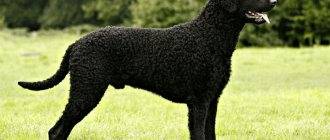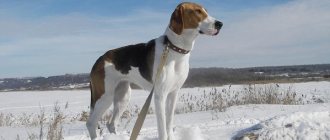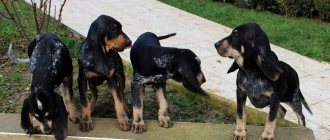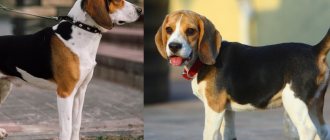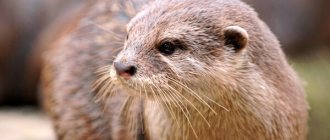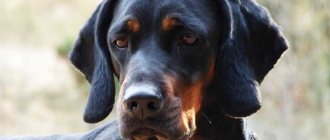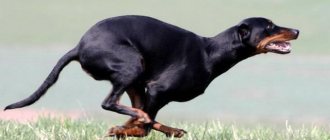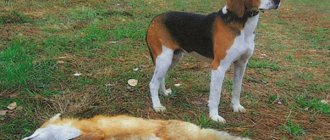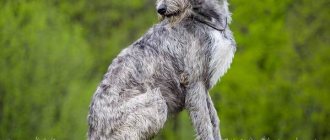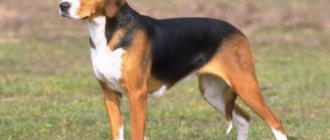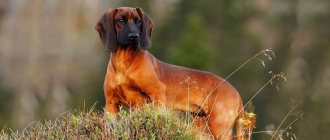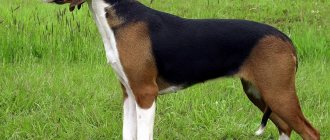Care and maintenance of the Otterhound
With good care and careful attention to the health of pets, Otterhounds can live up to 15-16 years, although their average life expectancy is from 10 to 13 years.
Physical activity and training are urgently needed for dogs of this breed. Dog competitions for hunting breeds, accompanying the owner on jogging or cycling walks, agility, swimming in various bodies of water - all this will help the dog be in good shape and mood. In addition, regular sports activities help control weight in dogs prone to obesity (especially neutered males).
The coat needs to be brushed weekly with a stiff brush, otherwise tangles will form. While in pet dogs these lumps can be cut off, in show dogs this is unacceptable; the hair in the area where it is cut takes quite a long time to grow back. The beard on the Otterhound's face requires special attention. While eating, pieces of food and water get stuck in the long hairs and if they are not removed immediately after eating, they begin to smell.
The Otterhound feels perhaps even better in water than on land. Photo by: Linda.
Droopy ears should be periodically examined by a veterinarian for the appearance of plugs, which can lead to inflammation - otitis media.
As a large and restless dog, it is better to keep the Otterhound in a private home rather than in an apartment. They should have a fenced-in area for walks in which they can splash out their energy. Hounds can live in the yard, but only if they have good shelter, a booth or an enclosure. Due to their thick coat and undercoat, they tolerate cold more easily than heat.
general characteristics
Otterhound, a dog belonging to the hound class. Its main characteristics:
- Large head.
- Powerful skull.
- Scissor bite.
- The muzzle is slightly elongated.
- Hanging ears.
- The body is slender with pronounced muscles.
- Strong paws. There are webs on the paw pads. They help the dog stay in the water for a long time.
- Long, thick coat with very good undercoat. Wool length 15 cm;
- The color can be with shades of blue or white (may have shades of black).
- At the withers, adult dogs can reach 68 cm.
- They weigh from 45 to 52 kg.
- Life expectancy is up to 13 years. There have been some cases where the dog lived to be 16 years old.
Nutrition
Otterhounds have a strong stomach and excellent digestion. They are not picky eaters. They can eat dry food or natural food.
Dry food can be bought in specialized stores. Hunting dogs love raw meat; it can be digested in the stomach without any problems, but it is not recommended to feed raw meat, as it contains dangerous trace elements, and the dog can get various diseases. What to feed:
- White meat chicken or turkey, beef, liver.
- Carrots, zucchini, pumpkin, cauliflower, broccoli.
- Fruits will provide vitamins.
- It is useful to give fish fillet.
Under no circumstances should you treat your dog with poultry and fish bones. Is it dangerous! They can cause enormous harm to the animal’s body, but do not bring any benefit.
The dog should have access to water around the clock. The water must be changed at least once a day. They will also not refuse treats. Dried tracheas, tails and ears are suitable for them. They can be purchased at a specialty store or prepared in a drying chamber.
Price
The cost of one purebred puppy is about $300. Depending on the pedigree, the price of an Otterhound . It is best to purchase a dog from trusted nurseries when it is at least two months old.
At this age, they begin to accustom the puppy to food or natural nutrition and it can be weaned from its mother. The breeder must carry out diagnostics and give the first vaccination. At the same time, an examination is carried out and genetic problems and possible congenital diagnoses are identified.
Appearance of a Russian hound
The Russian Hound is a dog of impressive size and strong constitution with somewhat feral habits. It is impossible not to note the external resemblance of representatives of this breed to wolves, which is especially clearly visible during hunting. For example, it is typical for a working hound to pursue prey with its head down, which is reminiscent of the tactics of a forest predator. The RG is also related to wolves by its physique features - in particular, its conspicuous high forwardness.
Head
The distinctive features of the Russian Hound's head are the general dryness of the contours and the wedge-shaped outline. The dog's skull is flattened, the eyebrows and the transition to the back of the head are faintly outlined.
Ears
The standard representative of the breed has thin, drooping ears set above the eye line. The ear itself should be triangular in shape and fit snugly to the head.
Neck
The length of the Russian Hound's neck is equal to the length of its head. In general, this part of the dog’s body looks dry and muscular at the same time.
Frame
Representatives of this breed are real strong men with harmoniously developed bones and dense, dry muscles. The chest of the Russian Hound is wide, strongly drooping downwards. The back is massive with a short, slightly convex, but fairly strong loin. The croup is elongated and sloping, the belly line is well selected.
The Russian Hound's legs are characterized by muscularity and moderate bonyness. In a healthy purebred individual, the forelimbs and hindlimbs are set parallel to each other and have good articulation angles. The animal's elbows look back, the pasterns and metatarsals are set almost vertically. The angles of the glenohumeral joints (100-110°) and hock joints are also well defined.
The shape of the Russian hound's paws is oval. The fingers are arched, gathered into a large ball.
Tail
The correct rut (tail) should be thick at the base, and its thin tip reaches the hock joint or is located higher by a centimeter or two (the latter feature is typical for males). In an excited animal, the tail can rise to the line of the back, but not higher.
Wool
The coat on the dog's body is double, but heterogeneous. For example, on the ears, head and legs of an animal, the hair is short and less dense. Around the neck and on the hips the dog is noticeably richer and more magnificent. The base and middle of the Russian Hound's tail are covered with medium-length hair, the tip is short.
Color
A typical Russian hound is a saddle, crimson or grayish and tan dog. The traditional color of tan marks is faded yellow or whitish. Sometimes small white marks may be present on the neck and legs, which is allowed by the standard.
Defects and disqualifying defects
In order not to be admitted to exhibition competitions, a Russian hound only needs to have a mousey or coffee-colored coat, suffer from heterochromia, or have a depigmented iris. The absence of a canine or molar M1, M2, as well as any deviations from a scissor bite, also lead to disqualification.
Serious developmental defects that do not exclude an animal from the ranks of competitors, but reduce its chances of getting a good grade to zero, include:
- short-legged or long-legged;
- stretched or shortened body;
- dry or damp constitution;
- color with bright red tan, speckling, as well as large white or dark spots on the ears, forehead and under the eyes;
- shaggy, wavy coat without undercoat;
- overgrown muzzle;
- pronounced snub nose;
- ears that are too large, shaggy, on cartilage or rolled into a tube;
- long neck with chin;
- absence of an incisor or four or more premolars.
Quite common and serious faults are: a narrow, underdeveloped chest, everted hocks, small angles of articulations, as well as a tail laid on its side, too short or with a pendulous tail.
Otterhound diseases
This breed most often has two pathologies: destruction (dysplasia) of the joints of the hip and pelvis, and also a twisted stomach. The first has a genetic basis and affects almost half of the representatives of the breed. Obvious signs of the disease are noticeable already at 4 months: the pet does not pull on the leash during walks, runs a little, and often sits on the floor at home. Over time, lameness appears and pain intensifies. After three years, the dog will be immobilized, so you need to contact an orthopedic surgeon as soon as possible. Only joint replacement surgery will restore the dog’s ability to walk normally, but it will no longer be able to run.
The second common disease is gastric volvulus with rupture of ligaments and bleeding. The reason is that the walls of the organ contract incorrectly. This condition often ends in death. Symptoms appear suddenly: the pet whines and does not lie down, saliva drips from the mouth. Within an hour, the stomach quickly swells and breathing is difficult. Call your veterinarian and take your dog to the doctor no later than five hours after signs of illness appear. Then she will be saved.
The average life expectancy is 10–12 years, the maximum is 14.
Vaccinations
Vaccination is carried out against the following diseases:
- canine distemper or distemper;
- parvovirus enteritis - the causative agent is parvovirus;
- infectious hepatitis - causative agent hepadnavirus;
- parainfluenza;
- rabies;
- leptospirosis;
- coronavirus;
- trichophytosis.
When should a puppy have his first vaccination?
- At 2 months the first vaccination is carried out. After the injection, the puppy should not be washed, overfed or taken outside. Immunity after the first vaccine is developed within 12 days; this period becomes the most dangerous for the baby. A person needs to make a lot of effort to alleviate the puppy’s condition. After the first vaccination, puppies experience increased body temperature, general weakness and diarrhea.
- After 3 weeks, the puppy is given a second vaccination, but with the same vaccine. As a rule, after the second vaccination the dog feels much better, but for 12 days it must be protected from other animals, from drafts and not taken out for walks. After this time, walks are allowed.
- At 6 months of age, the puppy is vaccinated against rabies and a complex vaccine against several diseases. It is forbidden to vaccinate if the dog's teeth are changing. You need to wait until all the teeth are replaced, and then vaccinate the baby.
- At one year of age, the dog is given a comprehensive vaccine.
- Further, once a year the dog should be vaccinated with the same complex vaccine.
How to vaccinate a puppy?
Only a qualified specialist should vaccinate a puppy .
Before vaccination, he must examine the dog, measure its body temperature, and only if everything is normal, give the injection. The vaccine is placed either in the scruff of the neck or in the hip of the dog. The entire list of vaccinations administered by the veterinarian must be recorded in the dog’s passport. It also indicates the date of vaccination; subsequently, the owner himself will know the expected date of the next vaccination.
Character
Otterhounds have a balanced and easy-going character. They are famous for their excellent hearing and sense of smell. They can catch game both in water and on land. Otterhounds hunt mink and nutria.
Training is one of the most important factors in raising such a dog. By nature, they are very stubborn and you will need to gain a lot of patience and strength in order to tame the pronounced canine temperament and subjugate their will.
Apartment conditions are absolutely not suitable for Otterhounds. These dogs are able to jump even from the fifth floor, as they have no sense of fear. They need a large and spacious yard. They have a lot of energy. Therefore, they should be loaded with physical exercise every day. It is not recommended to leave them alone at home, as they can make a mess in the shortest amount of time. The daily requirement is jogging, at least 1 hour a day. In principle, they can do without them, only then will it be possible to get a fat and lazy dog, which is a breed violation.
It is recommended to start training at 7 months. From puppyhood, without teaching the puppy good manners, the owner is in danger of raising a spoiled and arrogant dog. Only with affection, love, care and patience can you get an obedient and intelligent hunter in the person of a stubborn Otterhound.
The downside of Otterhounds is that they are too kind. They can treat both their family and strangers with all love. They are completely unsuitable for protection.
Seeing the thick coat of Otterhounds, you might think that such coat requires a lot of care, but this opinion is wrong. Maintenance is not a hassle. But still:
- Long and thick coat requires proper attention. It is enough to brush your dog once a week. The wool does not get tangled with each other. They don't shed much.
- You must remember to regularly wash your beard with it, otherwise it may give off a bad smell.
- Ears require care and attention. Ear plugs may form in them, and if I do not remove them, this will lead to inflammation of the ears (check daily). Wiping and cleaning your ears is a must.
- They love to swim. Washing them with shampoo is often not recommended (it dries out the skin). However, shaggy hunters will happily take a cool shower every day.
- Check your teeth. Plaque can be removed using special hygiene products.
- Otterhounds must be vaccinated or else they can become infected with various diseases that can even lead to their death.
Estrus
What should a bitch owner know?
- age of onset of the first estrus in a female is 6-12-14 months;
- duration of estrus is 20-22 days, sometimes up to a month;
- frequency of estrus – 1-2 times a year with an interval of 6-9 months;
- signs of estrus – swelling of the dog’s external genitalia, spotting;
- frequent urination - having to walk more often than usual;
- psychological signs - a change in the dog’s behavior - from aggressive to lethargic;
- perhaps there is a change in appetite and the dog drinks more water;
- often bitches begin to shed before going into heat;
- lick the loop intensively.
How to notice the onset of heat?
You can notice the approach of estrus while walking your dog. Behavior can change, often the dog becomes active, playful and disobedient, or, on the contrary, looks unhappy and lethargic. The bitch makes frequent marks - scent “lures” for male dogs, and urination occurs more frequently. The loop becomes more and more swollen; when pressed, you can see a discharge of light pink or dull pink color. If you notice changes in the dog's behavior, do not be lazy and check the dog every day for the onset of heat by dabbing the bitch's loop with a napkin or toilet paper. Pinkish discharge will be the beginning of estrus - mark this day in your dog’s notebook.
The course of the dog's first heat.
- The first heat in dogs is not the same as the next one.
- It may be shorter or longer than the usual estrus period.
- The bitch has either only weak manifestations of estrus, or, conversely, very heavy discharge.
- The first heat may suddenly stop, and then after some time begin again.
- There may be mucous discharge from the loop, a smell that attracts males, and the estrus itself will begin after some time.
- Try not to miss the start time of the first, and subsequently the second estrus, in order to correctly determine the intervals between estrus and know their timing and duration.
Precautions during estrus.
If you are not interested in getting puppies from a dog, you need to take precautions during heat:
- walk your dog ONLY on a leash: even the most obedient dog these days can simply run away, not paying attention to commands;
- do not allow male dogs to mount the dog: if sexual intercourse begins, it is almost impossible to separate them;
- during a walk, literally DO NOT take your eyes off the dog, even when buying bread in a tent, eliminate or minimize contact with male dogs;
- there is a danger of the dog catching a cold in the cold season, the best way to protect yourself is not to walk for a very long time in cold weather and use dog clothes;
- If your dog lives freely on your territory, then from the moment the estrus begins, lock the dog in an enclosure.
Description and features
The breed's specialization is otter hunting in marshy areas. Hound dogs do an excellent job of finding an animal's lair under water, and they track down prey of other types on land as well. The physical form of dogs reflects their readiness for exercise. Powerful skeleton, muscular body, large head. The floppy ears are set low and pressed tightly to the sides. At the ends they are curled into a curl, which uniquely distinguishes the Otterhound breed.
The expression on the face is friendly, the look of the shaggy pet is very expressive, reflecting interest, strength, and independence. Dark eyes are covered with fur. The nose is graphite-colored or brown. The Otterhound has an excellent sense of smell and a rare bass voice.
Free movements of the hound, a wide step in gait resembles an active trot. The dog has a huge pushing force to accelerate the sweeping run. The dog quickly catches up with its prey. Surprisingly, when walking, the dog seems to drag his feet, barely lifting them from the ground.
The peculiarity of movement is deceptive - thanks to their strong limbs, dogs are able to tirelessly cover tens of kilometers. The height of the dog at the withers is approximately 65 cm, weight is 35-50 kg. Males are large in size and weight. A straight, saber-shaped tail, wide at the base and narrow at the tip.
The Otterhound has a peaceful, active character.
Dogs became excellent swimmers thanks to their long limbs with membranes between their toes. The widening of the feet in the water helps the animal to successfully row at a decent speed. Webbed feet with large black pads.
For water hunting, nature has endowed dogs with special hair. Double waterproof cover, slightly oily to the touch. The guard hair is like a wire, hard, rough, and has the property of curling. The length of the fur on the body is up to 8 cm, on the limbs it is half as long. Dense fur allows the dog to work even in icy water.
The Otterhound in the photo captivates with its spontaneity, playfulness, and shaggy appearance. Deviation from the standard in the presence of very long hair leads to disqualification, as it interferes with the working qualities of the dog. When wet, the severity of the coat reduces the physical resource of the animal.
The curly coat was admired in the past by the royals of the English court. Modern dogs are allowed to be exhibited in their natural form - with unkempt fur without tangles, feathering or dewlap. When preparing a dog for showing, you can comb the dog's coat, but do not cut it. The color is allowed in one color or in combinations of several colors. The pigment of the coat should match the shade of the nose and eyes.
Otterhound
Story
The Otterhound is an older breed related to the Bloodhound. It was used for otter hunting. The dog has a sharp nose and great endurance.
The Otterhound is a rare breed.
Description
A big, strong, muscular dog. The head is large and narrow, the muzzle is as long as the skull with a large, black nose. The eyes are small and dark. The ears are large, long, drooping and covered with long hair. The tail is long. It has strong legs, large paws with interdigital membranes. Color black, gray, wheaten, brown, black and brown.
- Otterhounds require a lot of exercise. Vigorous daily exercise, running or swimming for several miles is necessary to maintain his physical and mental health.
- Otterhounds are enthusiastic and loud barkers.
- You shouldn't expect guard qualities from him - he's too friendly for that.
- A fenced yard is a must.
- The Otterhound loves food and can become obese if you don't control its diet.
- A big dog requires a lot of expenses. Everything for a larger dog costs more, from food to veterinary care.
Personality
A dog with a very well developed sense of smell, intelligent, cheerful, friendly and well balanced.
Temperament
The Otterhound gets along very well with other animals and people. He is very friendly with people, including strangers.
Education
The dog is quite difficult to train, but with consistent, balanced, steady training without being rough or heavy, good results can be achieved in training an Otterhound.
A haircut
The Otterhound's coat needs to be brushed every day. You may need to wash your beard because it can smell bad if you don't keep it clean.
The dog is resistant to atmospheric changes. The Otterhound enjoys living outdoors in a fenced yard where it can roam freely, but can adapt to apartment living if it gets the proper exercise. Otterhound dogs require socialization and professional training.
Common diseases
An Otterhound may be prone to the following conditions:
- gastric dilatation (volvulus);
- hip dysplasia;
- canine idiopathic thrombocytopenia.
Pointing hunting dogs
Pointers are one of the most numerous groups of hunting dogs. The animals got their name due to their habit of “lying down” when they smell game. Pointers were first bred in the 15th century in Spain, where they were used to catch game birds. Representatives of this class have excellent hearing, sense of smell. They are able to find shot game in almost any area, so they are used for hunting waterfowl, pine forest, field, and marsh birds.
Among the most popular pointing breeds are:
- Irish, Scottish, English setters;
- Langhaar;
- kurtshaar;
- drathaar;
- Czech fousek;
- Weimaraner.
Health and life expectancy
The breed has some health problems. The most common dysplasia of the hip and elbow joint. In addition, Otterhounds may suffer from:
- Epilepsy;
- Ear infections;
- Gastric volvulus;
- Thrombasthenia;
- Degenerative myelopathy;
- Lymphosarcoma;
- Angiosarcoma;
- Autoimmune disease;
- Atheroma;
- Heart diseases;
- Allergies.
In adulthood, the dog's coat becomes coarser, loss of muscle tone, excess weight, weakness, development of arthrosis and arthritis, impaired vision, hearing and other age-related problems are noted. Life expectancy is 10-12 years.
Breeds from the same group
- Australian (kangaroo) greyhound
- Australian Terrier
- Austrian Shorthaired Pinscher
- Azawakh
- Ainu (Hokkaido Inu, Ainu-ken, Hokkaido dog, Hokkaido)
- Akita Inu
- Alopekis
- Alaskan Malamute
- American Blue Gascony Hound (Big and Blue)
- American Indian dog
- American Cocker Spaniel
- American Staffordshire Terrier
- American Toy Terrier (American Toy Fox Terrier)
- American Foxhound (American Foxhound)
- Amur Laika (Indana)
- Anatolian Shepherd
- English Beagle
- English cocker spaniel
- English Pointer (Pointer)
- English Setter (Laverack)
- English Foxhound (Foxhound, American Foxhound)
- Dogo Argentino (Argentine Mastiff, Dogo Argentino)
- Artois Hound (Chien d'Artois)
- Ariège marriage (Ariege pointer, artesien Norman, bracque de Toulouse)
- Afghan Aboriginal Hound (Bakhmul)
- Afghan Hound (Afghan)
- Africanis (lion dogs)
- African hairless dog
- Affen pinscher (monkey pinscher)
- Bakhmul (Afghan Aboriginal Hound)
- Banjar Greyhound
- Basenji (Nyam Nyam Terrier)
- Basset Hound
- Batak Spitz (Pomeranian dog, Batak dog of Sumatra)
- Bedlington Terrier (Rothbury Terrier)
- Beagle Harrier
- Billy (Biya)
- Dogue de Bordeaux (Dogue de Aquitaine, French Mastiff)
- Bosnian Barrack (Bosanski Gonjic, Bosnian Rough-haired Hound, Ke
- Fila Brasileiro (Fila Brasileiro, Brazilian Mastiff, Brazilian Mol
- Breton fawn basset (Breton Basset, Red Breton Basset)
- Bourbon braque
- Buryat-Mongolian wolfhound (Hottosho)
- Wachtelhund (German Spaniel, German Quail Dog)
- Welsh Springer Spaniel
- Welsh Terrier
- Hungarian Greyhound (Magyar Agar)
- Hungarian Vizsla (Vizsla, Hungarian Shorthaired Pointer, Hungarian
- East Siberian Laika
- West Highland White Terrier (West Highland White Terrier, White Highland
- Hanoverian Hound
- Smooth Fox Terrier
- Blue Gascony Griffon
- Hamilton's Hound (Hamiltonstövare)
- Greyhound (English greyhound)
- Greenland dog (Greenland dog)
- Greek hare hound (Hellenic Iknilatis)
- Griffon cortalsa (French Wirehaired Pointer Griffon)
- Jack Russell Terrier
- Jämtland Laika (Emthund, Yemthund, Yamthund, or Swedish Elkhound,
- Wire Fox Terrier
- West Siberian Laika
- Golden retriever
- Irish Water Spaniel
- Irish Wolfhound
- Irish Setter
- Irish Terrier
- Spanish Water Dog (Perro De Acqua Español)
- Italian Segujo (Italian Hound)
- Kai (Brind dog, Kai, Tora Inu, koshu-tora, kai-ken, deer hunting
- Cane Corso Italiano
- Keeshond, Wolfspitz
- Cairn Terrier
- Kerry Blue Terrier
- Kyrgyz Shepherd
- Kishu (Kishu-inu, Kishu-ken)
- Clumber Spaniel
- Cocker Spaniel
- Kromforlander
- Labrador Retriever
- Laika
- Latvian hound
- Levesque
- Lesser Swiss Hound
- Lesser Vendean Basset Griffon (Petit Basset Griffon)
- German Wirehaired Pointer (Drathaar)
- German Hunting Terrier (German Jagdterrier)
- Nova Scotia Retriever (Nova Scotia Duck Retriever, Norwich Terrier
- Norwegian Elkhound (Norwegian Elkhound)
- Norwegian Lundehund (Norwegian Puffin Husky, Norsk Lundehund, Lun
- Norwegian Elghound black
- Ogar (Polish Ogar)
- Otterhound (Otter Hound)
- Parson Jack Russell Terrier
- Pitbull
- Podenco Canario
- Pointer (English Pointer)
- Polish Hound (Polish Ogar)
- Polish ogar
- Portuguese Water Dog (Cao De Acqua)
- Portuguese Podengo
- Poodle
- Rhodesian Ridgeback
- Romanian Mioritic Shepherd Dog
- Russian hunting spaniel
- Russian Spaniel
- Russian-European Laika
- Samoyed dog (Samoyed, Samoyed Spitz)
- Saint-Germain Bracque
- Serbian Hound (Balkan Hound, Yugoslav Hound)
- Stabihon (stabihunzhe, stebihun)
- Taigan (Kyrgyz Greyhound)
- Thai Ridgeback
- Dachshund
- Whippet
- Pharaoh Hound (Pharao Hound, Old Egyptian Greyhound)
- Finnish Hound (Tricolored Finnish Hound, Suomenajokoira)
- French white and orange hound
- Harrier dog
- Cirneco dell'Etna (Sicilian Greyhound)
- Shar Pei
- Silky Windhound (Silky Whippet, Windhound, Small Borhound
- Shikoku (Shikoku, Kochi-ken, Mikawa Inu)
- Styrian hound (Styrian marriage, Styrian rough-haired highland
- Epagnole Pont Audemer
- Airedale
How to choose a puppy
- Litters can contain from 7 to 10 puppies, although cases where more or fewer babies are born are also not uncommon.
- The best age to buy a Bloodhound puppy is 2-3 months. You can also take older animals, but raising and training them will be more difficult.
- For normal development, Bloodhound babies require a lot of free space, so choose breeders who prefer country growing. Keeping an adult bitch and her restless cubs in an apartment is a complete mockery of the breed.
- Increased fatness of a Bloodhound puppy in the first months of life is normal. The main thing is that it does not survive until 8 months of age: the breed is prone to obesity, which entails a number of ailments no less dangerous to health.
- Find out from the seller whether testing for hereditary dysplasia has been carried out on bloodhound breeders. Breeders who have nothing to hide willingly share X-rays and examination results with buyers.
- Find out what kind of litter the bitch has. It is worth finding out not only the total number of births, but also finding out at what intervals the litters were born. If less than a year has passed between the last two matings, it is logical to assume that the breeder is simply making money on animals, without regard for their health.
- When choosing a future hunter, find out whether his immediate ancestors have working diplomas. A Bloodhound puppy from a first-class tracker usually inherits the parent's talents.
Norfolk Terrier
This is a relatively young breed of burrowing dogs, bred in the territory of the English county of the same name. It was derived from the Scottish Terrier and was officially recognized in 1964.
Norfolk is a small dog, growing to 22 - 25 cm at the withers and weighing about 5 kg. On a wide dome-shaped head with a wedge-shaped muzzle are oval dark eyes and triangular ears tilted forward. Under the elongated body with strong bones and a strong neck are short, straight limbs with gathered fingers and thick pads. The entire body of such a dog is covered with a hard spine with a thick undercoat. As for the color, it can be red, wheaten or black with graying.
Norfolks are excellent burrowing dogs, endowed with the appropriate disposition. They are very energetic, resilient, agile and stubborn. These dogs get along well with children and do not show aggression towards people. They cannot stand loneliness and are easy to train. When walking around the city, they should not be let off a leash, as they may chase a random cat, mistaking it for prey.
Tornjak: a brief historical background
Tornjak (or Tornjak) belongs to the group of mountain herding dogs. The appearance and skeletal structure of the breed suggest that its roots come from Tibetan mastiffs. The first descriptions of this dog date back to the 9th century. It originated in the Balkans, or more precisely, in the region now part of Bosnia and Herzegovina. Most of the population here was engaged in sheep farming, since the mountainous terrain is not particularly suitable for growing crops. Tornjaks performed and still perform the role of guards and protectors of sheep from attacks by predators. Any farm keeps several of these dogs to ensure the safety of the herd at night and during the period of free grazing.
The function of the tarnjak is protection from predators during the day and at night; it does not control the behavior of sheep
Previously, this breed was called differently:
- in Bosnia - Bosnian Shepherd dogs;
- in Croatia - Croatian mountain dogs.
The name Tornjak comes from the word “thorn” - a pen for livestock, and is associated with the main focus of the use of these domestic animals.
Despite the popularity of Tornjaks in this region, the breed could have disappeared if not for the enthusiasm of local dog handlers. In the small town of Travnik, located between Sarajevo and Banja Luka, a dog breeders club was created to revive the breed and its official recognition. At the request of the club, a monument to Tornjak was erected in Travnik.
A monument to the dog was erected near the playground, which once again emphasizes the good-natured attitude of this big dog towards children.
At the same time, work was carried out in Croatia. The work of dog handlers to restore the breed has yielded the following results:
- purebred breeding began in 1978;
- in 1981, the breed was registered in Yugoslavia itself under the name Bosnian-Herzegovina-Croatian Shepherd Dog (Tornjak or Tornjak);
- in 1990, a breed standard was adopted;
- in 2007 - official recognition by the Federation Cynologique Internationale (FCI); Its registration record is numbered 355.
After receiving official status, dogs of this breed can often be seen at international exhibitions.
Now in the territory of the former Yugoslavia there are a large number of purebred representatives of this breed.
Interesting Facts
It is no coincidence that the Otterhound breed was valued by royalty. Amazing dogs amaze with their physical endurance and inventive mind:
- the otter hound is tireless in pursuit, it will continuously swim for prey for up to 6 hours, and run on land twice as long;
- the dog's acute sense of smell allows him to catch the otter's scent 8 hours later, or to feel during the day that the animal was in the water last night;
- pets living in the house show extraordinary determination if they smell a scent that interests them - they open the doors of refrigerators, cabinets, and overcome high fences;
- the fearlessness of hounds can harm the dog - pets can only be kept on the first floors, since animals are able to jump out of the window even from the fifth.
An ancient breed, unfortunately, cannot adapt itself to a changing world. The future of beautiful Otterhound dogs depends only on humans.
Training
The breed is quite difficult to train, so it is not very suitable for novice dog owners. As mentioned earlier, they are self-sufficient and independent and can be quite stubborn during training. The best motivation for them is a treat, so you should always have one with you.
The training process should not be long, and it is very important that you finish it when you consider it necessary, without giving in to the dog’s desire to do it as early as possible. Consistency is Key to Dog Training
Training should be made tempting so that the dog has a desire to train, and you should under no circumstances give up or make concessions.
No matter how well trained a dog is, you should not walk it without a leash, much less give it freedom in a park or square. Seeing small animals, they will instinctively begin to chase them and immediately run after them, not listening to your calls and commands to return home or be nearby.
Therefore, you should not leave her alone with other pets. Their instinct to chase is too strong and one day it may take over and another pet may get hurt, be it a cat or a rodent. As you understand, rodents are in even greater danger than other pets.
The Otterhound loves to bark, and the barking can be unpleasant at times, especially when it turns into a howl.
Therefore, take this fact into account, especially if you are the owner of an apartment and not your own home
It should also be noted that the Otterhound breed is dirty, so be careful. They will jump and swim in dirty puddles, and then, as expected, run ahead of you into the house, dirty and soaking wet. While swimming, they feel as if they are in a small pond, and begin to splash around in the water, spilling and splashing it around them.
Interesting Facts
It is no coincidence that the Otterhound breed was valued by royalty. Amazing dogs amaze with their physical endurance and inventive mind:
- the otter hound is tireless in pursuit, it will continuously swim for prey for up to 6 hours, and run on land twice as long;
- the dog's acute sense of smell allows him to catch the otter's scent 8 hours later, or to feel during the day that the animal was in the water last night;
- pets living in the house show extraordinary determination if they smell a scent that interests them - they open the doors of refrigerators, cabinets, and overcome high fences;
- the fearlessness of hounds can harm the dog - pets can only be kept on the first floors, since animals are able to jump out of the window even from the fifth.
An ancient breed, unfortunately, cannot adapt itself to a changing world. The future of beautiful Otterhound dogs depends only on humans.
Owner reviews
When I was 4 years old, our family had an Otterhound named Norte, whom we loved very much. I can't keep a dog like this in the city (New York), but I wouldn't be surprised if my parents or brother wanted to take the puppy off your hands to the suburbs of Boston.
Mango_Punch
https://www.reddit.com/r/rarepuppers/comments/8u6cld/this_is_pearl_shes_an_otterhound_and_with_less/
Rain is perfect weather for my hooligan! We went for a walk before it started, and now she refuses to come into the house. I’m wet, I’m calling her, but she doesn’t listen. He just stands and looks at the sky.
Appearance
The Utonagan is a large, strong, lightly built dog. Well balanced, which is reflected in agility, speed and power. At first glance it resembles a wolf. Sexual dimorphism is well expressed. Males are noticeably stronger and larger.
- Height at withers: 61-84 cm.
- Weight: 25-50 kg.
The head is proportional, never too wide. The eyes are almond-shaped, from light amber to dark brown. The muzzle is quite long. The lobe is dark brown or black. The ears are set wide apart, the tips slightly rounded. The jaws are powerful and well developed. Scissor bite. The neck is long, strong, and seems heavy due to the abundant “mane.”
Although the utonagan often looks like a wolf, it does not contain the blood of its wild relatives.
The chest is narrow, the shoulders are moderately sloping. The forelimbs are straight, long, spaced at a short distance from each other, elbows pressed to the body. The case has a slightly stretched format. The topline is level. The hind limbs are powerful, muscular, wider apart than the forelimbs, parallel. The feet are webbed, the front feet are oval and large, the back feet are smaller. The tail is long, often with a thick dewlap.
The coat is dense, thick, straight. The coat in the summer months is very different from the winter, when an abundant undercoat grows. The traditional color of the utonagan is zonal.
general characteristics
Otterhound, a dog belonging to the hound class. Its main characteristics:
- Large head.
- Powerful skull.
- Scissor bite.
- The muzzle is slightly elongated.
- Hanging ears.
- The body is slender with pronounced muscles.
- Strong paws. There are webs on the paw pads. They help the dog stay in the water for a long time.
- Long, thick coat with very good undercoat. Wool length 15 cm;
- The color can be with shades of blue or white (may have shades of black).
- At the withers, adult dogs can reach 68 cm.
- They weigh from 45 to 52 kg.
- Life expectancy is up to 13 years. There have been some cases where the dog lived to be 16 years old.
